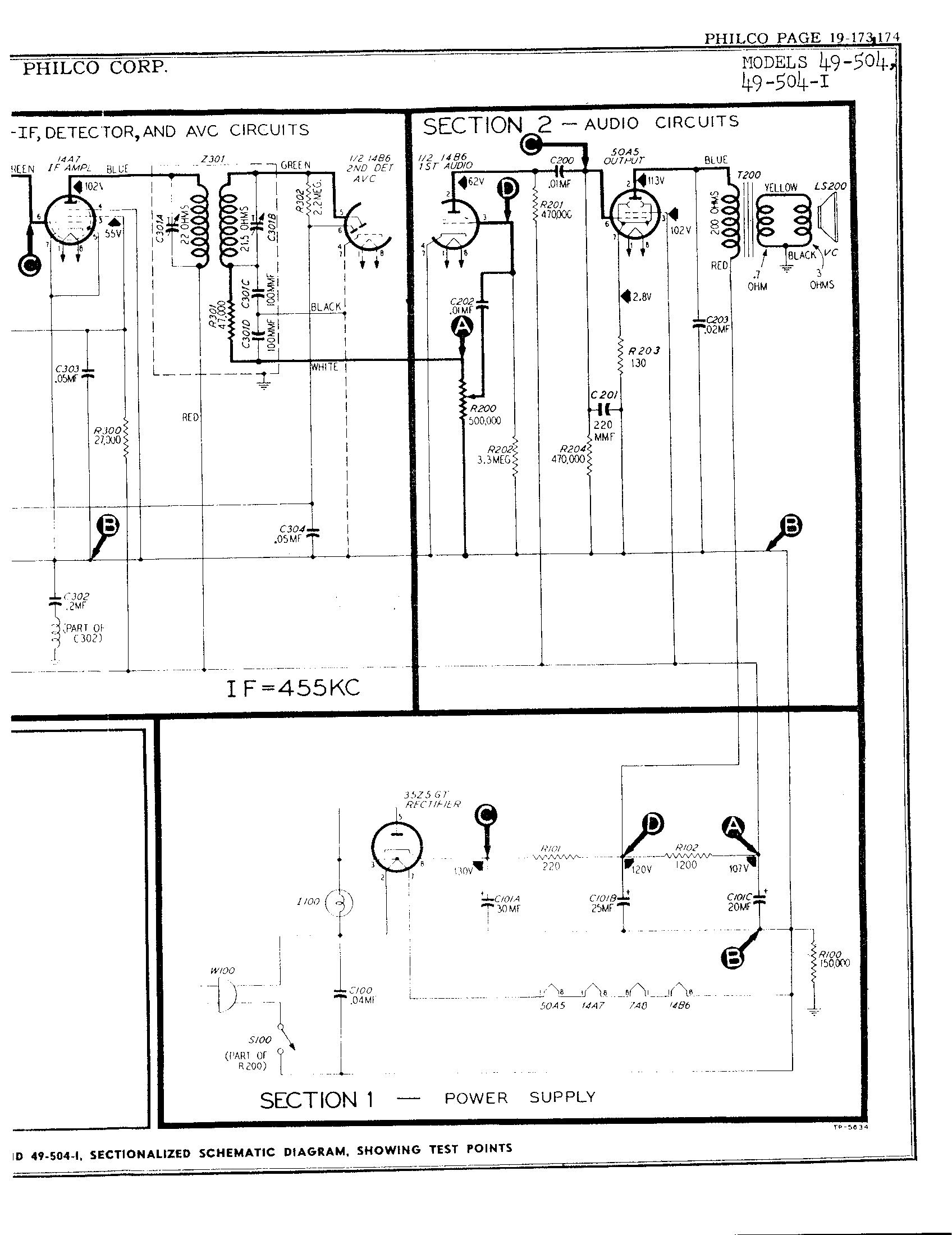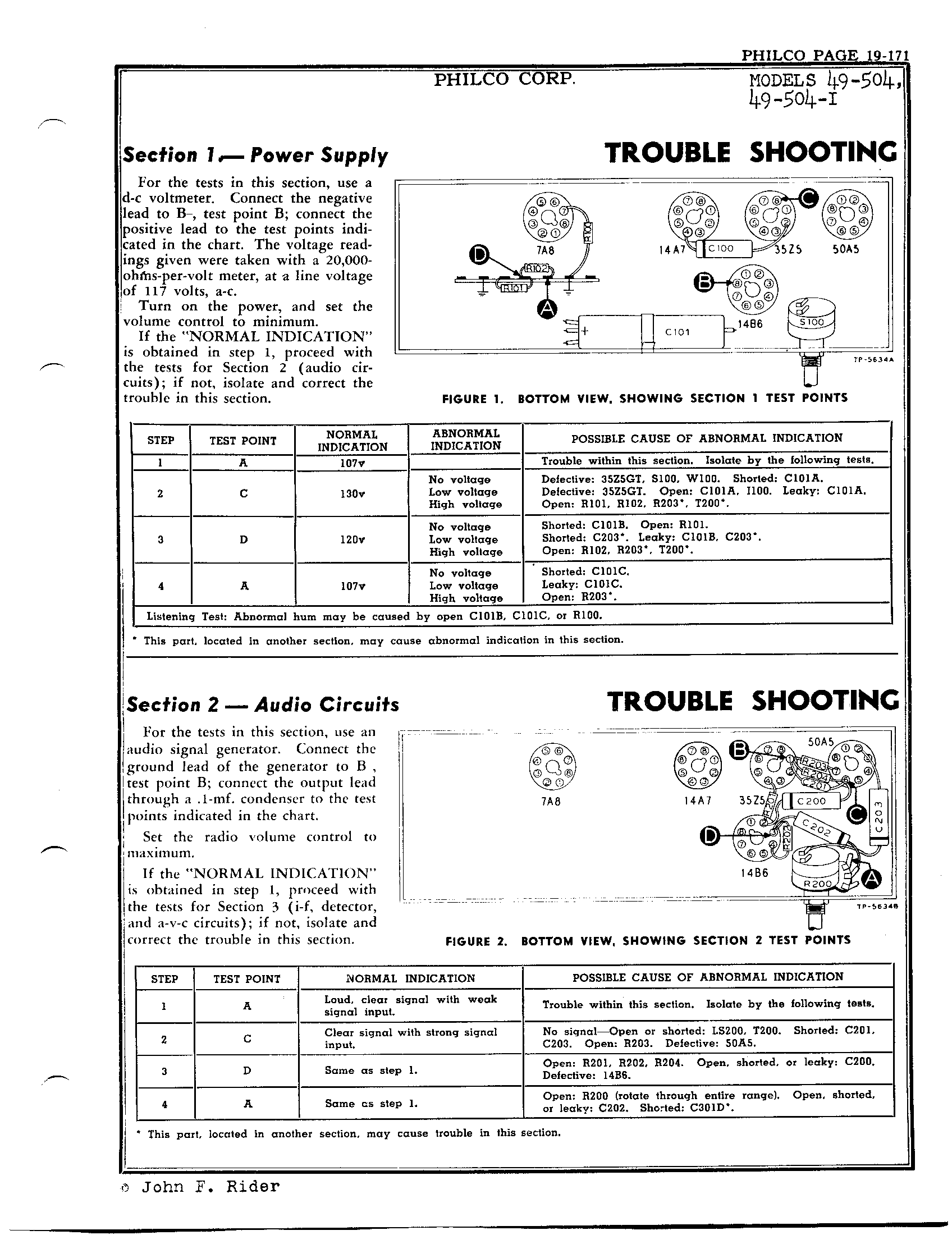49-504 voltage drop / pilot lamp spike problem
Posts: 1,531
Threads: 242
Joined: Sep 2012
City: West Bend, Wisconsin
Working on this last year of the familiar Philco transitone that began production in 1941 and am puzzled as to why I'm getting a rapid voltage (and volume) drop after about 90 seconds to 2 minutes playing. I've replaced every single cap and resistor in the radio. There is one disc mica I left in over in the RF section.
Here's the PDF schematic from the Philco Resources section:
https://philcoradio.com/library/download...8-1949.pdf
and here is the actual pages in lesser quality:


in the POWER SUPPLY section:
From point B to A, I get 70 volts (should be 107)
From point B to C, I get 112 volts (should be 130)
From point B to D, I get 84 volts (should be 120)
When I first turn the set on, measuring from point B to C, it starts out at 123 volts and stays stable for about 90 seconds. Then the rapid descent starts down to 112 where it stays, but the volume drops dramatically and becomes garbled.
Now I know there is an open filament tap problem that can develop with the 35Z5 tube, but I've tried 3 different NOS tubes with the same result.
The set has also been blowing #47 dial bulbs like popcorn. I left the bulb out and measured the socket voltage. It starts out at 4.4 volts (when I'm getting the 123 volts from point B to C), but as that voltage drops, the socket voltage spikes to 17 volts, which of course blows the bulb.
Any thoughts on what could be causing this? I checked solder joints, even went to overkill 5 watt resistors on R101 (220 ohm) and on R203 (130 ohm) as both were getting very hot.
Greg V.
West Bend, WI
Member WARCI.org
Posts: 7,295
Threads: 268
Joined: Dec 2009
City: Roslyn Pa
The problem is in the hv circuit as it's related to the lamp thru the heater tap/plate connection. If you are sure all of the caps are good I would replace the rubber wire in the hv and heater circuits. Slim chance that you may have something like a shorted primary winding on the output transformer. Could have a tube w/a short that is pulling the hv down.
Happy Hunting!
When my pals were reading comic books
I was down in the basement in my dad's
workshop. Perusing his Sam's Photofoacts
Vol 1-50 admiring the old set and trying to
figure out what all those squiggly meant.
Circa 1966
Now I think I've got!
Terry
Posts: 1,119
Threads: 44
Joined: Feb 2015
City: Roseville, MN
Seems like a short somewhere causing the audio output tube to conduct heavily. One that occurs after warmup. The bulb voltage is weird.
Posts: 94
Threads: 9
Joined: Feb 2013
City: Monroeville, PA
Try measuring the voltage across the filaments of each tube to see which one is dropping and causing the voltage across the dial light to surge. The one that changes significantly may be your bad tube or at least lead you to a section to look at.
Posts: 95
Threads: 34
Joined: Oct 2016
City: Fountain Hills, Arizona
I agree with RodB. The voltage drop across the 220 ohm resistor between points C and D indicate an additional ~82MA being drawn by the audio output tube.This additional 82 MA would also flow through the lamp causing a significant increase in voltage across the lamp.
Posts: 1,531
Threads: 242
Joined: Sep 2012
City: West Bend, Wisconsin
Thanks for all of the great ideas. I found something tonight that may add a piece to the puzzle.
I did a filament voltage check on all of the tubes. Pins 1 & 8 on the loctals, and 2 and 7 on the rectifier. I checked them cold, after 2 minutes and after 5 minutes. This was done WITHOUT the dial lamp bulb in the socket.
14B6 13.3v (cold), 12.6v (after 2 min), 12.3v (after 5 min)
50A5 46.5v (cold), 46.5v (after 2 min), 45.8v (after 5 min)
14A7 11.7v (cold), 11.7v (after 2 min), 11.7v (after 5 min)
7A8 7.5v (cold), 7.3v (after 2 min), 7.3v (after 5 min)
35Z5 44.4v (cold), 44.0v (after 2 min), 45.6v (after 5 min)
As you can see, they stayed fairly stable. However this may be a clue:
I left the leads from the meter on pins 2 and 7 of the 35Z5, turned the set off, and replaced the dial bulb into the socket. When I turned the set back on, I got 35.8v, which quickly jumped to 36.2. After only 1 minute playing, the volume dropped dramatically, and the dial lamp bulb started glowing brighter.
With the bulb out of the socket, the radio was playing fine. Volume stayed steady. But obviously not a good thing because the 35Z5 was running nearly 10 volts higher than it should without the bulb to bring the voltage down to around 35v.
Greg V.
West Bend, WI
Member WARCI.org
Posts: 94
Threads: 9
Joined: Feb 2013
City: Monroeville, PA
Have you tried changing the 50A5? It is possible it is dragging everything down or has an internal short once warmed up. Also, did you measure the resistance of the Primary side of the Audio Output transformer?
Some designs include a shunt resister across the bulb for situations where the radio is drawing more than 60ma through the 35Z5. You may want to do this, at least temporarily, until you figure out the real cause. See tube spec sheet for details.
To figure out which tube is pulling the voltage down, you may have to insert a meter and measure the current through each tube. Once you figure out the tube, focus on the voltages on the various grids.
Posts: 1,119
Threads: 44
Joined: Feb 2015
City: Roseville, MN
Another quick check would be to see if the electrolytic caps are installed properly, negative side to B-.
Posts: 95
Threads: 34
Joined: Oct 2016
City: Fountain Hills, Arizona
It would be interesting to know the voltages at pin 6 and pin 7 of the 50A5 before and after the two minute warm-up.
Posts: 1,531
Threads: 242
Joined: Sep 2012
City: West Bend, Wisconsin
Well after all of that hair tugging and beating my head against the wall it turns out it was the (blankety blank) 50A5 tube after all! I had two different used tubes in the socket and both had tested good on my tube tester. I then found an NOS tube in the box I forgot I had and when I popped that one in the voltage came down in line, albeit a few volts low. But all tubes were consistent in the few volts low and most importantly the voltage stayed stable...as did the dial light brightness and the volume / clarity of the radio. I guess both of those used tubes had the same internal short that my tube tester didn't detect.
So my thanks to all for your help. Bill and 45Phicodon, you pointed my grey matter in the right direction!
Greg V.
West Bend, WI
Member WARCI.org
Posts: 94
Threads: 9
Joined: Feb 2013
City: Monroeville, PA
Glad to hear you got it going.
Users browsing this thread: 1 Guest(s)
|
|
Recent Posts
|
|
Zenith H725
|
| hello Ed,
how about that speacial tape used for ducting it's like foil or how about thin piece of
aluminum roof flash...radiorich — 12:19 AM |
|
Zenith H725
|
| Ed;
One material that I have seen, but never tried for this was material for making exhaust gaskets, it's similar to ...Arran — 11:42 PM |
|
Zenith H725
|
| I just remembered, I have some hi temp silicone rubber material which could do the trick. Or a piece of FR4 laminate. Th...EdHolland — 08:39 PM |
|
Zenith H725
|
| The PSU filter cap arrived today (thank you USPS!) so I will work on that later.
Meanwhile, I have the dial, speaker...EdHolland — 06:42 PM |
|
Philco 610B oscillator wiring
|
| Thanks Terry. After checking my notes I think I recorded about -10v at the 6A7 G4/control grid. The screen grid (G3 &...Tubester — 05:59 PM |
|
The list of my radio & TV collection!
|
| Magical chords of forgotten melodies, old nostalgic music on an old radio... Saturday night blues on the Mid-Waves on an...RadioSvit — 12:20 PM |
|
Philco 42-345 Restoration/Repair
|
| Thank you MrFixr55 the issue with this radio is that the internal coil antenna is missing and there was a wire in its pl...osanders0311 — 11:34 AM |
|
Philco 610B oscillator wiring
|
| Regarding the oscillator circuit which is comprised of the 6A7's cathode, control grid, and screen grid. These elements ...Radioroslyn — 10:33 AM |
|
Philco 42-345 Restoration/Repair
|
| Hi OSanders,
First off, welcome to the Philco Phorum where Phine Phamily-Phriendly Pholks Phull of Philco Phacts and P...MrFixr55 — 08:41 AM |
|
Philco 42-345 Restoration/Repair
|
| Today I've been reading through the site trying to learn more about this radio. I also soldered the lose power cord cabl...osanders0311 — 08:24 PM |
|
Who's Online
|
| There are currently no members online. |

|
 
|





![[-] [-]](https://philcoradio.com/phorum/images/bootbb/collapse.png)


